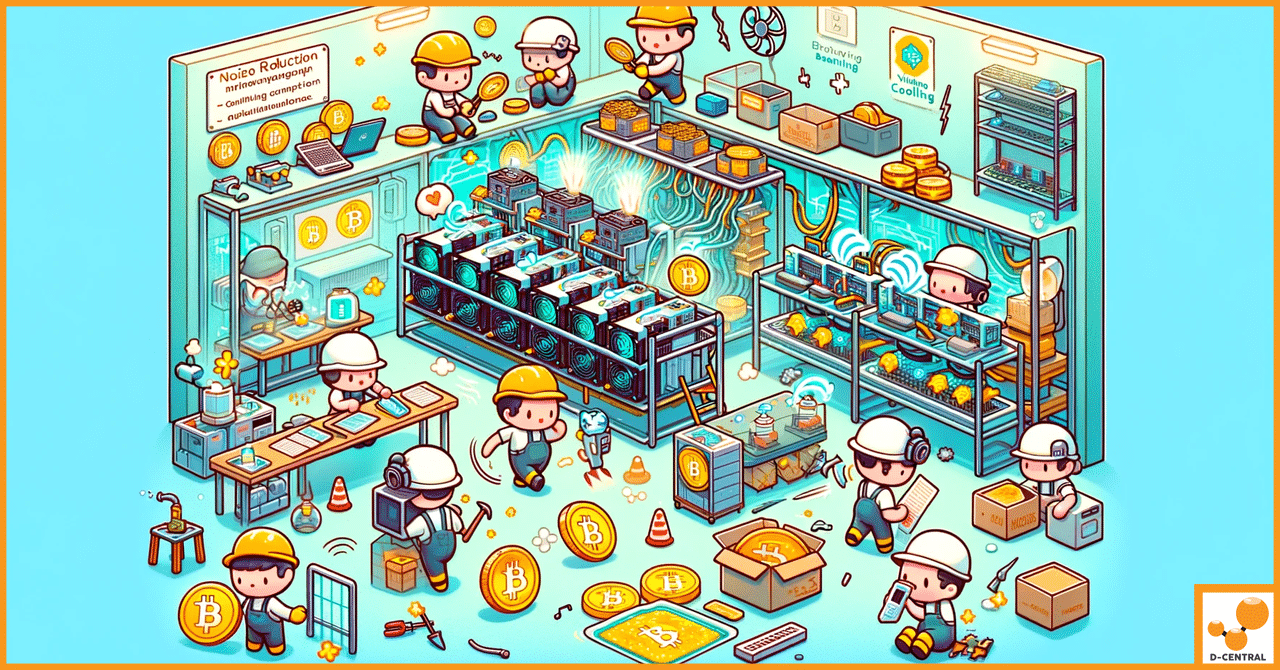
Overview of Noise Reduction & Cooling for ASIC Miners
In the dynamic world of cryptocurrency mining, ASIC (Application-Specific Integrated Circuit) miners have emerged as the backbone of the industry,
4479 Desserte Nord Autoroute 440, Laval, QC H7P 6E2

Bitcoin mining, the process of validating transactions and securing the network while generating new bitcoins, has evolved significantly since Bitcoin’s inception in 2009. Initially, mining was possible on simple computer systems. However, as the network grew, so did the difficulty of mining, leading to the development of specialized hardware known as Application-Specific Integrated Circuits (ASICs). These powerful machines are designed exclusively for mining cryptocurrencies, offering unparalleled efficiency and speed compared to their predecessors. The advent of ASIC miners marked a pivotal shift in the mining landscape, setting new standards for what it means to engage in this competitive arena.
Despite the dominance of ASIC miners, a burgeoning interest in alternative mining methods has emerged within the crypto community. This interest is driven by various factors, including the high cost and accessibility issues associated with ASIC hardware, as well as a desire for more decentralized and democratic mining practices. As a result, enthusiasts and innovators alike are exploring ways to mine Bitcoin without relying on ASIC technology. These alternative mining methods, ranging from using graphics processing units (GPUs) to joining cloud mining services, offer a glimmer of hope for those looking to participate in Bitcoin mining without the hefty investment in ASIC miners.
The exploration of non-ASIC mining methods is not just about finding cost-effective solutions; it’s also about embracing the original ethos of cryptocurrency — making mining accessible to a broader audience and reducing the concentration of mining power. As we delve deeper into the possibilities of mining Bitcoin without ASIC miners, it’s essential to understand the challenges and opportunities that lie ahead. This growing interest in alternative mining methods signals a vibrant and evolving mining ecosystem, where innovation and inclusivity could pave the way for a more diverse and resilient Bitcoin network.
The landscape of Bitcoin mining has undergone significant transformations, with the advent of Application-Specific Integrated Circuits (ASICs) representing one of the most pivotal shifts. ASIC miners are specialized hardware designed exclusively for mining cryptocurrencies, particularly Bitcoin. Unlike their predecessors—CPUs (Central Processing Units) and GPUs (Graphics Processing Units)—ASIC miners are not general-purpose devices; they are engineered to perform the specific computational tasks associated with mining at unparalleled speeds and efficiency.
ASIC miners are the culmination of the evolution in mining technology, tailored to optimize the process of solving the complex cryptographic puzzles that secure the Bitcoin network and validate transactions. These devices achieve this by executing the SHA-256 hashing algorithm, the cryptographic function at the heart of Bitcoin’s proof-of-work consensus mechanism, with unmatched proficiency. The “application-specific” part of their name underscores their singular focus: they are built from the ground up to mine Bitcoin or other specific cryptocurrencies that use the same algorithm, without the capability to perform general computing tasks.
ASIC miners have become the backbone of the Bitcoin mining industry, primarily due to their efficiency and the competitive edge they provide. In the race to mine the next block and reap the rewards—a fixed amount of Bitcoin plus transaction fees—speed and power efficiency are paramount. ASIC miners excel in both, significantly outperforming CPUs and GPUs by orders of magnitude in terms of hash rate, the number of hash functions a miner can perform in a given time frame.
ASIC miners represent the cutting edge of Bitcoin mining technology, offering unparalleled efficiency and speed. Their role in securing the Bitcoin network and ensuring the profitability of mining operations underscores their importance in the cryptocurrency ecosystem. However, the dominance of ASICs also raises questions about mining centralization and accessibility, prompting ongoing discussions and innovations within the community.
The evolution of Bitcoin mining into an industry dominated by Application-Specific Integrated Circuits (ASICs) has significantly raised the barriers to entry for individuals and small-scale operations. Those attempting to mine Bitcoin without ASIC technology face a myriad of challenges, primarily due to the inherent limitations of alternative mining hardware such as CPUs, GPUs, and even FPGAs (Field-Programmable Gate Arrays). These challenges not only affect the feasibility of mining efforts but also impact the potential profitability and sustainability of such endeavors.
One of the most significant hurdles for non-ASIC miners is the stark difference in energy efficiency and computational power. CPUs and GPUs, while versatile and capable of handling a variety of tasks, are not optimized for the specific demands of Bitcoin’s proof-of-work algorithm. This lack of specialization results in significantly lower hash rates compared to ASIC miners, meaning that non-ASIC hardware must work harder and consume more energy to perform the same amount of mining work. The increased energy consumption not only elevates operational costs but also diminishes the environmental sustainability of mining activities, making it a less attractive option for eco-conscious miners.
Bitcoin mining is inherently competitive, with miners around the globe vying to solve cryptographic puzzles first and earn block rewards. The introduction of ASIC miners has escalated this competition to unprecedented levels, as these devices can hash at a rate several magnitudes higher than non-ASIC hardware. For miners without access to ASIC technology, this competitive landscape presents a daunting challenge. The probability of successfully mining a block and receiving rewards without ASICs is significantly reduced, making it difficult for non-ASIC miners to justify the investment of time and resources.
The difficulty of mining Bitcoin adjusts approximately every two weeks to maintain a consistent block time of about 10 minutes, regardless of the total computational power on the network. As more ASIC miners join the network and contribute their superior hashing power, the difficulty increases, making it harder for all miners to find the next block. This adjustment mechanism further exacerbates the challenges faced by miners using less efficient hardware. As the difficulty rises, the already slim chances of success for non-ASIC miners diminish even further, pushing the mining landscape towards an ASIC-dominated environment.
In summary, the challenges of mining Bitcoin without ASIC technology are manifold, encompassing not only the technical and economic inefficiencies of alternative hardware but also the competitive and adaptive nature of the mining process itself. These factors combine to create a scenario where mining without ASICs is increasingly impractical, prompting miners to either invest in ASIC technology, explore alternative cryptocurrencies less dominated by ASICs, or exit the mining space altogether. The ongoing evolution of the mining industry continues to raise important questions about decentralization, accessibility, and the future of cryptocurrency mining.
As the Bitcoin mining landscape becomes increasingly dominated by ASIC miners, individuals and small-scale miners explore alternative methods to participate in the mining process. These alternatives, including CPU mining, GPU mining, cloud mining, and joining mining pools, offer varied entry points into the mining ecosystem, each with its own set of advantages and challenges.
Description and Feasibility: CPU mining utilizes the processor of a computer to perform mining operations. In the early days of Bitcoin, CPU mining was feasible and commonly practiced. However, as the network grew and the mining difficulty increased, CPU mining became largely impractical for Bitcoin due to its lower processing power compared to specialized mining hardware.
Pros and Cons:
Explanation and Viability: GPU mining uses the graphics processing units of powerful video cards to mine cryptocurrencies. GPUs are more efficient than CPUs due to their ability to handle complex calculations simultaneously, making them suitable for mining cryptocurrencies that are resistant to ASIC mining.
Overview and Functioning: Cloud mining allows individuals to participate in cryptocurrency mining by renting processing power from a cloud mining service provider. This method eliminates the need for personal mining hardware, reducing the barriers to entry.
Introduction and Mechanism: Mining pools are groups of miners who combine their computational resources to increase their chances of mining a block and receiving rewards. The rewards are then distributed among pool members according to their contributed processing power.
Keywords: mining pools, combined mining efforts.
In conclusion, while ASIC miners dominate Bitcoin mining, alternative mining methods provide avenues for participation in the cryptocurrency mining ecosystem. Each method offers a unique set of advantages and challenges, catering to different preferences, resources, and goals of miners.
Mining Bitcoin without ASIC technology requires strategic planning and optimization to enhance efficiency and potentially increase profitability. Given the dominance of ASIC miners in the Bitcoin network, individuals seeking to mine Bitcoin with alternative hardware must focus on optimizing their operations and managing costs effectively. Here are tailored strategies for those aiming to mine Bitcoin without ASICs, emphasizing the importance of electricity costs and hardware optimization.
Mining Bitcoin without ASIC miners presents significant challenges, primarily due to the network’s competitive nature and high difficulty level. However, by carefully managing electricity costs, optimizing hardware and software, and considering collaborative efforts like joining mining pools, miners can still participate in the Bitcoin network. While the rewards may be smaller and less frequent, the endeavor contributes to the decentralized ethos of Bitcoin and allows for broader participation in the cryptocurrency space.
The journey into mining Bitcoin without the use of ASIC miners is fraught with challenges, yet it is not devoid of possibilities. While the limitations are clear—lower efficiency, higher energy consumption, and the daunting competition from ASIC-equipped miners—the exploration of alternative mining methods remains a testament to the innovative spirit of the cryptocurrency community. The landscape of Bitcoin mining is emblematic of a broader narrative in the tech world, one where technological advancements continually reshape what is possible.
For those undeterred by the hurdles, mining Bitcoin without ASIC technology offers a unique opportunity to engage with the cryptocurrency ecosystem from a different vantage point. It allows miners to contribute to the network’s security and decentralization while navigating the complexities of this competitive arena. The key to navigating this path lies in staying informed about technological advancements and being adaptable to the ever-evolving mining landscape.
The realm of cryptocurrency mining is dynamic, with new technologies and strategies emerging regularly. For miners, this means that today’s challenges could be mitigated by tomorrow’s innovations. Whether through improvements in non-ASIC hardware efficiency, advancements in mining software, or the development of more sustainable energy solutions, the future holds untold possibilities for those willing to explore and innovate.
We encourage miners who have ventured into the world of Bitcoin mining without ASICs to share their experiences and insights. Your journey, challenges, and successes can inspire others and contribute to a collective understanding of alternative mining methods. Whether through comments on this article, forum discussions, or social media exchanges, your story is an invaluable part of the broader conversation on cryptocurrency mining.
To stay at the forefront of mining technologies and strategies, consider subscribing to newsletters and following relevant social media accounts and blogs. These resources can be a treasure trove of information, offering updates on the latest in hardware developments, software optimizations, and mining pool opportunities.
In conclusion, while mining Bitcoin without ASIC miners presents significant challenges, it remains a viable path for those committed to exploring the boundaries of what is possible in the cryptocurrency mining space. By staying informed, adaptable, and engaged with the mining community, you can navigate the complexities of this endeavor and potentially uncover new opportunities in the ever-evolving landscape of Bitcoin mining.
What are ASIC miners?
ASIC miners are specialized hardware designed exclusively for mining cryptocurrencies like Bitcoin. They perform mining operations with unparalleled efficiency and speed due to their focus on executing specific cryptographic tasks, such as the SHA-256 hashing algorithm used in Bitcoin mining.
Why is mining Bitcoin with ASIC miners so competitive?
Mining Bitcoin with ASIC miners is highly competitive because these devices offer superior efficiency and hashing power, significantly increasing the chances of solving cryptographic puzzles and earning mining rewards. Their performance outmatches CPUs, GPUs, and other non-ASIC hardware, making ASIC miners the preferred choice for serious miners.
What challenges do miners face without ASIC technology?
Miners without ASIC technology struggle with lower efficiency and higher energy consumption when compared to ASIC miners. This makes mining less feasible due to increased operational costs, reduced profitability, and the competitive disadvantage in solving puzzles required to earn Bitcoin rewards.
What are some alternative mining methods to ASIC mining?
Alternative mining methods include CPU mining, GPU mining. Each method offers different entry points into the mining ecosystem, with varying levels of investment, efficiency, and potential profitability. These methods cater to those looking to mine Bitcoin or other cryptocurrencies without investing in ASIC technology.
How can miners without ASICs potentially increase their chances of success?
Miners can optimize their non-ASIC mining setups by selecting efficient hardware, managing electricity costs effectively, using optimized mining software, and joining mining pools. These strategies can help improve efficiency, reduce costs, and increase the likelihood of earning mining rewards, even without ASIC technology.
What role does renewable energy play in non-ASIC mining?
Utilizing renewable energy sources, such as solar or wind power, can help lower the operational costs and environmental impact of mining activities. This approach can make mining more sustainable and potentially more profitable, particularly in regions with higher electricity rates.
Why is it essential for miners to stay informed and adaptable?
The Bitcoin mining landscape is continually evolving, with new technologies, strategies, and market dynamics emerging regularly. Miners need to stay informed about these developments to make timely adjustments to their mining operations, ensuring they remain competitive and profitable over time.
DISCLAIMER: D-Central Technologies and its associated content, including this blog, do not serve as financial advisors or official investment advisors. The insights and opinions shared here or by any guests featured in our content are provided purely for informational and educational purposes. Such communications should not be interpreted as financial, investment, legal, tax, or any form of specific advice. We are committed to advancing the knowledge and understanding of Bitcoin and its potential impact on society. However, we urge our community to proceed with caution and informed judgment in all related endeavors.
Related Posts

In the dynamic world of cryptocurrency mining, ASIC (Application-Specific Integrated Circuit) miners have emerged as the backbone of the industry,

In the ever-evolving landscape of investment and property management, diversification stands as the cornerstone of financial resilience and growth. Amidst

In the ever-evolving landscape of global finance, Bitcoin emerges as a revolutionary force, challenging traditional monetary systems and redefining the